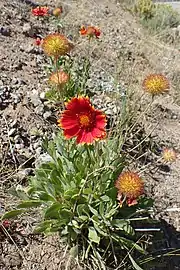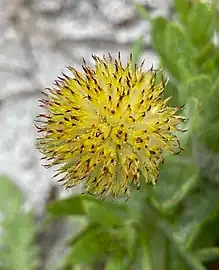| Gaillardia pulchella | |
|---|---|
.jpg.webp) | |
| Indian blanket inflorescence | |
| Scientific classification | |
| Kingdom: | Plantae |
| Clade: | Tracheophytes |
| Clade: | Angiosperms |
| Clade: | Eudicots |
| Clade: | Asterids |
| Order: | Asterales |
| Family: | Asteraceae |
| Genus: | Gaillardia |
| Species: | G. pulchella |
| Binomial name | |
| Gaillardia pulchella Foug., 1788 | |
| Synonyms[2] | |
|
Synonymy
| |
Gaillardia pulchella (firewheel, Indian blanket, Indian blanketflower, or sundance) is a North American species of short-lived perennial or annual flowering plants in the sunflower family.[3][4][5][6][7][8]
Description
The branching stem of G. pulchella is hairy and upright, growing to 60 centimetres (24 inches) tall.[9] The leaves are alternate, mostly basal, 4–8 cm (1+5⁄8–3+1⁄8 in) long, with edges smooth to coarsely toothed or lobed. It has a hairy stem, simple or branched near the base, where the leaves are essentially located towards the bottom of the plant.
The pinwheel, daisy-like inflorescences are 4–6.5 cm in diameter,[9] vividly colored with red, orange and yellow and is surrounded by 10 to 20 ray florets up to 2 cm;[9] the ligule has three lobes. The central disc florets of the flower head tend to be more red-violet, with the outer ray florets being yellow. In one variety, almost the entire flower is red, with only the barest tips of the petals touched with yellow. It typically blooms from May to July,[9] but does so practically year-round in some areas.
The fruit is an achene, almost pyramidal, hairy, and prolonged by a pappus 5 to 8 millimetres (3⁄16 to 5⁄16 in) in length.[10][11]
Distribution and habitat
It is native to northern Mexico (Chihuahua, Coahuila, Nuevo León, Sonora, Tamaulipas) and the southern and central United States from Arizona east to Florida and the Carolinas and north as far as Nebraska.[12] It is also naturalized in scattered locations in other parts of the U.S. as well as in Québec, Ontario,[9] China, South Africa, and parts of Central and South America. The plant generally lives in the sandy plains and deserts of the south of the North American continent. It is common along the roads and prefers sandy soils. It can also grow on vacant lots in urban areas, but generally below 1,000 metres (3,300 feet) above sea level.[13]
The flower has also been introduced to the Penghu Islands in Taiwan, where it is the County Flower of Penghu County. It is called "天人菊" ("Tianren Daisy") in Chinese.[14]
Ecology
The plant is a larval host to the bordered patch butterfly (Chlosyne lacinia) and the painted schinia moth (Schinia volupia), which feed upon its foliage.[15]
Cultivation
G. pulchella is a hardy plant, not picky about soil, though sandy and well-drained are best. It has a high drought tolerance and does best with a dry, hot climate in full sun. Its vibrantly colored flowers can be seen carpeting fields and the sides of highways for miles in the summer to late fall. Favored by honeybees, it produces a dark reddish amber buttery tasting honey. In the garden, the flowers can be deadheaded to promote further blooming. It self-seeds freely.
Cultivars

Gaillardia pulchella (with the perennial Gaillardia aristata) is the parent of Gaillardia × grandiflora, a hybrid, from which several cultivars have been created. One of these is 'Sundance Bicolor', a perennial double-form with the flower heads having florets of alternating red and yellow. Because of its bright colors, it is well adapted in the sun. Others are 'Goblin' and 'Tangerine'.[16][17]
Culture
It is the state wildflower of Oklahoma.
Gallery
 Entire plant
Entire plant Side view of flowers
Side view of flowers Flower close-up
Flower close-up Lighter seedhead
Lighter seedhead_(cropped).jpg.webp) Darker seedhead
Darker seedhead
References
- ↑ NatureServe (4 August 2023). "Gaillardia pulchella". NatureServe Network Biodiversity Location Data accessed through NatureServe Explorer. Arlington, Virginia: NatureServe. Retrieved 24 August 2023.
- ↑ The Plant List, Gaillardia pulchella Foug.
- ↑ Turner, B. L. 2013. The comps of Mexico. A systematic account of the family Asteraceae (chapter 11: tribe Helenieae). Phytologia Memoirs 16: 1–100
- ↑ Jørgensen, P. M., M. H. Nee & S. G. Beck. (eds.) 2014. Catálogo de las plantas vasculares de Bolivia, Monographs in systematic botany from the Missouri Botanical Garden 127(1–2): i–viii, 1–1744
- ↑ Nelson, C. H. 2008. Catálogo de las Plantas Vasculares de Honduras 1–1576. Secretaria de Recursos Naturales y Ambiente, Tegucigalpa
- ↑ Gibbs Russell, G. E., W. G. M. Welman, E. Retief, K. L. Immelman, G. Germishuizen, B. J. Pienaar, M. Van Wyk & A. Nicholas. 1987. List of species of southern African plants. Memoirs of the Botanical Survey of South Africa 2(1–2): 1–152(pt. 1), 1–270(pt. 2).
- ↑ Flora of China, Gaillardia pulchella Fougeroux, 1788. 天人菊 tian ren ju
- ↑ United States Department of Agriculture Plant Profile: Gaillardia pulchella
- 1 2 3 4 5 Spellenberg, Richard (2001) [1979]. National Audubon Society Field Guide to North American Wildflowers: Western Region (rev ed.). Knopf. pp. 374–375. ISBN 978-0-375-40233-3.
- ↑ Flora of North America: Gaillardia pulchella Fougeroux, 1788. Firewheel, Indian blanket
- ↑ "Gaillardia pulchella". Germplasm Resources Information Network. Agricultural Research Service, United States Department of Agriculture. Retrieved 24 December 2017.
- ↑ Biota of North America Program 2014 county distribution map
- ↑ MacMahon JA (1997) Deserts , National Audubon Society Nature Guides, AA Knopf Inc. ISBN 0-394-73139-5
- ↑ "Penghu County Flower".
- ↑ The Xerces Society (2016), Gardening for Butterflies: How You Can Attract and Protect Beautiful, Beneficial Insects, Timber Press.
- ↑ Colorado State University: Gaillardia pulchella 'Sundance Bicolor'
- ↑ Seeds and More: Gaillardia 'Sundance Bicolor'
External links
- Image Archive of Central Texas Plants
- Ajilvsgi, Geyata. Wildflowers of Texas. Shearer Publishing, revised edition 2003. ISBN 0-940672-73-1
- Floridata: Gaillardia pulchella
- Encyclopedia of Oklahoma History and Culture – Indian Blanket Archived 2010-10-18 at the Wayback Machine
